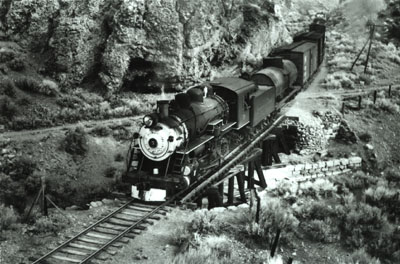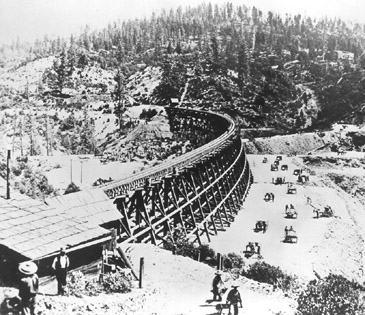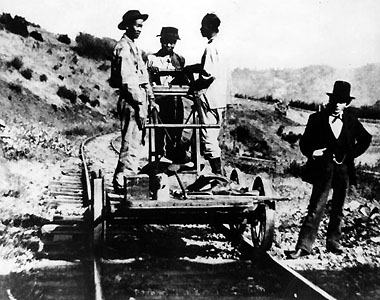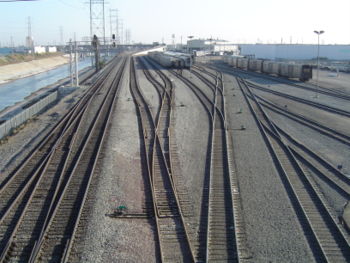Railroad Track
 Railroad tracks are used on railways (or railroads), which, together with railroad switches, guide trains without the need for steering. Tracks consist of two parallel steel rails, which are fastened to the ties with rail spikes or clips.
Railroad tracks are used on railways (or railroads), which, together with railroad switches, guide trains without the need for steering. Tracks consist of two parallel steel rails, which are fastened to the ties with rail spikes or clips.
The concept of running heavy carriages on a "rail road" of parallel rails or tracks wasn't entirely new, it was in common use in Medieval mines and in other industries. The use of rails offered reduced friction and guided the carriages so they didn't need to be steered.
Horses provided the pulling power on these early tramroads or railroads. Cast iron rails were introduced in England in the 1770's, and a superior wrought Iron "edge rail" was introduced in the 1790's.
Robert Livingston Stevens designed the first "T" shaped rail, the hook-headed spikes, and the "iron tongue" or fishplate used to join the rails on the Camden and Amboy Railroad, designs commonly used on railroads today.
Steel rails can carry heavier loads than any other material. English inventor Henry Bessemer developed a process that lowered the cost of production of steel in 1856. Steel rails were introduced on the Pennsylvania Railroad in 1863, and by 1890 were in use on 80 percent of the railroads. Steel rail thickness is typically measured by the weight of a three foot section of rail. During the 1860's 62 to 78 lb. rail were commonly used. As railroad locomotives and cars became larger and heavier during the following decades, stronger heavier rail replaced the older lighter rail. Heavier rails and trackwork can support heavier and faster trains. Today rail is commonly manufactured or "rolled" in weights from 112 to 145 lb. per yard and stands six to eight inches high. In cross section rail is an inverted "T", and today every dimension is manufactured to American Railway Engineering Association (AREA) standards.
 Rail has been traditionally manufactured in 39 foot long pieces so it can be placed in a 40 foot long car. Joint bars, also sometimes refered to as fishplate, are used to bolt the sections of rail together. In recent years, welded rail has become more commonly used for higher traffic rail lines. Welded rail is usually assembled in 1,500 ft. lengths at a central facility, then transported on a special permanently coupled rail train. The remaining joints can be eliminated by in-place welding.
Rail has been traditionally manufactured in 39 foot long pieces so it can be placed in a 40 foot long car. Joint bars, also sometimes refered to as fishplate, are used to bolt the sections of rail together. In recent years, welded rail has become more commonly used for higher traffic rail lines. Welded rail is usually assembled in 1,500 ft. lengths at a central facility, then transported on a special permanently coupled rail train. The remaining joints can be eliminated by in-place welding.
The type of fastener depends partly on the type of tie, with spikes being used on wooden ties, and clips being commonly used on concrete ties. Steel tie plates fit under the steel rails and on top of the wooden ties, the tie plates have holes that the spikes go through, these help spread the load of the rail over a larger area of the tie to help prevent crushing the wood.
Railroad ties spread the load from the rails over the ground and also serve to hold the rails a fixed distance apart, called the gauge. Standard gauge is 4 feet 8 1/2 inches between the rails. This common gauge allows freight cars to be transferred from one railroad to another when a shipper and their customer are served by different railroads in other parts of the country. This spacing was commonly used on English tramways before the invention of the steam locomotive. Standard gauge was widely used in Europe and was adopted by most railroads in the United States after President Abraham Lincoln designated 4 feet 8 1/2 inches as the gauge for the Pacific Railroad being built to the Pacific coast in 1863.
Some early southeastern railroads were built as 5 foot gauge. Some nineteenth century railroads were built as narrow gauge with 3 feet or 3 feet 6 inch spacing between the rails. While narrow gauge railroads were typically less expensive to build, especially in mountain areas, the cost of transferring goods between railroads was higher. Shipments to and from customers served by narrow gauge railroads needed to be unloaded and transferred to different cars when they arrived at the exchange point with a standard gauge railroad.
 The right of way is a strip of land of varying width upon which the railroad track and other facilities are located. It is wide enough to provide for tracks, drainage, signals, bridges, sidings, buildings and other requirements. The right of way is graded to form a roadbed which is even and either level or a very gradual grade uphill or downhill. Embankments are constructed to support the track and to provide a compromise in terms of the route's average elevation. Bridges or trestles are constructed to cross rivers and valleys to maintain the railway's elevation, and gradients are kept within manageable constraints. Culverts may be constructed to cross small streams or water runoff channels.
The right of way is a strip of land of varying width upon which the railroad track and other facilities are located. It is wide enough to provide for tracks, drainage, signals, bridges, sidings, buildings and other requirements. The right of way is graded to form a roadbed which is even and either level or a very gradual grade uphill or downhill. Embankments are constructed to support the track and to provide a compromise in terms of the route's average elevation. Bridges or trestles are constructed to cross rivers and valleys to maintain the railway's elevation, and gradients are kept within manageable constraints. Culverts may be constructed to cross small streams or water runoff channels.
Railroad tracks are normally laid on a bed of coarse stone gravel known as ballast, which combines resilience, some amount of flexibility, and good drainage. Across bridges, track is often laid on ties across longitudinal timbers or longitudinal steel girders. The ballast may be anywhere from six inches to 30 inches deep below the ties.
The main line of a railway is a track that is used for through trains or is the principal artery of the system from which branch lines, yards, sidings and spurs are connected. It generally refers to a route between towns, as opposed to a route providing suburban or metro services. For capacity reasons, busy main lines are often double tracked, allowing trains to move in opposite directions on parallel tracks at the same time. Operationally, main line tracks are typically broken into segments or blocks for safe and efficient operation, with only one train allowed to move within a block at a time. Block signals and train orders are used to indicate which train is authorized to use the block.
A branch line is a secondary railway line which branches off a more important through route, usually a main line. A very short branch line may be called a spur line. Independently owned branch lines are typically refereed to as short line railroads.
 A railroad switch or turnout is a special section of track that mechanically allows trains to move from one track to another, such as a branch line, siding, spur or to a main line. A railroad switch with a track that diverges to the right is refereed to as a right hand switch and a railroad switch with a track that diverges to the left is refereed to as a left hand switch. Other types of switches are more specialized, including a crossing, which allows to rail lines to cross; a crossover, which is a pair of turnouts connecting two parallel tracks; a double-slip or "puzzle" switch which combines the functions of a crossing and a turnout where space is limited; and a ladder track is a series of turnouts providing access to any of several yard tracks.
A railroad switch or turnout is a special section of track that mechanically allows trains to move from one track to another, such as a branch line, siding, spur or to a main line. A railroad switch with a track that diverges to the right is refereed to as a right hand switch and a railroad switch with a track that diverges to the left is refereed to as a left hand switch. Other types of switches are more specialized, including a crossing, which allows to rail lines to cross; a crossover, which is a pair of turnouts connecting two parallel tracks; a double-slip or "puzzle" switch which combines the functions of a crossing and a turnout where space is limited; and a ladder track is a series of turnouts providing access to any of several yard tracks.
In the Los Angeles rail yard photo, a crossover can be seen between the two main line tracks on the far left. A right hand switch can be seen in the middle of the picture, the movable "switch points" are positioned for a train to continue directly forward. Two ladder tracks can be seen on the right side of the photo connecting tracks in the yard.
A siding is a section of track alongside a main line or branch line that typically connects to through track or to other sidings at either end. The distinction between sidings and other types of track is that a "siding" generally denotes an auxiliary or not exactly specified usage. Sidings are typically used for passing or for storage. Sidings often have lighter rails, meant for lower speed or less heavy traffic.
A rail yard, or railroad yard, is a complex series of railroad tracks for storing, sorting, or loading/unloading, railroad cars and/or locomotives. Railroad yards have many tracks in parallel for keeping rolling stock stored off the mainline, so that they do not obstruct the flow of traffic.
A Gandy dancer is a slang term for workers who maintained railroad tracks in North America. Over time the weight of trains over curves would cause the track to shift outward. Nineteenth and early twentieth century track crews used specialized hand tools known as gandies to align rail tracks into position. For each stroke, each worker would lift his gandy and force it into the ballast to create a fulcrum, then in unison with other workers use his full weight so the gandy would push the rail toward the inside of the curve. The same track crews also performed the other aspects of track maintenance, such as removing weeds, tamping down ballast, and replacing rotten ties.
Sharing A Heritage Railroad History Train Technology Railroad Operation Railroad Time Museums & Heritage Railroads Railroads Today
